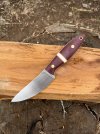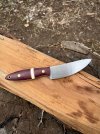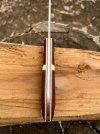-
The BladeForums.com 2024 Traditional Knife is available! Price is $250 ea (shipped within CONUS).
Order here: https://www.bladeforums.com/help/2024-traditional/
You are using an out of date browser. It may not display this or other websites correctly.
You should upgrade or use an alternative browser.
You should upgrade or use an alternative browser.
Magnacut Thread - Photos and Advice
- Thread starter Stacy E. Apelt - Bladesmith
- Start date
Joseph Bandeko
Knifemaker / Craftsman / Service Provider
- Joined
- Dec 9, 2021
- Messages
- 1,372
Just realized I never posted a photo of the finished product! (One of them is going to be for me, which I haven't had the time to finish)A couple of custom utility hunter's in Magnacut, rough ground and ready for heat treatment.
This is my first time working with it, and so far it's really nice to work with, easy to drill, easy to grind.
Can't wait to see how it works after HT!
View attachment 1844072
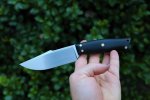
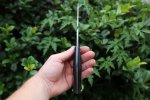
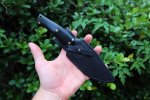
Last edited:
Joseph Bandeko
Knifemaker / Craftsman / Service Provider
- Joined
- Dec 9, 2021
- Messages
- 1,372
Hey all,
I've got a couple pieces of hardened Magnacut that I would like to anneal and re-heat treat, what is the best way to go about doing that? Can I simply do the anneal and that's it? if so, what temp, soak time and cooling rate would be best? Or should there be some sort of normalization before annealing?
It might be better to start an all new thread, but thought it a fitting question to be asked here.
I've got a couple pieces of hardened Magnacut that I would like to anneal and re-heat treat, what is the best way to go about doing that? Can I simply do the anneal and that's it? if so, what temp, soak time and cooling rate would be best? Or should there be some sort of normalization before annealing?
It might be better to start an all new thread, but thought it a fitting question to be asked here.
deerrockknives
Only thing I’m sure about, I know nothing for sure
Knifemaker / Craftsman / Service Provider
- Joined
- Mar 2, 2020
- Messages
- 563
Why do you need to anneal? Are you planning on doing some reprofiling or other machining work? If you are trying to reharden it to get to a higher HRC then just reharden it skipping any other steps since it's likely already in an optimal condition.Hey all,
I've got a couple pieces of hardened Magnacut that I would like to anneal and re-heat treat, what is the best way to go about doing that? Can I simply do the anneal and that's it? if so, what temp, soak time and cooling rate would be best? Or should there be some sort of normalization before annealing?
It might be better to start an all new thread, but thought it a fitting question to be asked here.
You shouldn't need to do any normalizing or grain refinement steps if it had already been through that. Unless you are doing something like forging or overheating, etc.
Maybe let us know what you are planning on doing and we can help further
Joseph Bandeko
Knifemaker / Craftsman / Service Provider
- Joined
- Dec 9, 2021
- Messages
- 1,372
The existing heat treat should be fine, but I'd like to anneal them so I can stamp my makers mark in them and maybe do some fill work, and once that's done I will probably tweak the heat treat a little from what they have now.Why do you need to anneal? Are you planning on doing some reprofiling or other machining work? If you are trying to reharden it to get to a higher HRC then just reharden it skipping any other steps since it's likely already in an optimal condition.
You shouldn't need to do any normalizing or grain refinement steps if it had already been through that. Unless you are doing something like forging or overheating, etc.
Maybe let us know what you are planning on doing and we can help further
Though I would like to try forging Magnacut at some point, so it would be nice to know what to do for that as well!
From Larrin's site on thermocycling steel. It doesn't appear that you will have to do anything other than anneal for your stamp, file work, etc then reharden and temper.The existing heat treat should be fine, but I'd like to anneal them so I can stamp my makers mark in them and maybe do some fill work, and once that's done I will probably tweak the heat treat a little from what they have now.
Though I would like to try forging Magnacut at some point, so it would be nice to know what to do for that as well!

How to Thermal Cycle Knife Steel - Knife Steel Nerds
Experiments and recommendations on how to process steel after forging. Hardness, toughness, microstructure. Some controversial conclusions!
Now if you do any forging you can back up further down the charts and do some normalizing and grain refinement but with the extra elements in magnacut I don't think it is as important. Shouldn't hurt anything though


Joseph Bandeko
Knifemaker / Craftsman / Service Provider
- Joined
- Dec 9, 2021
- Messages
- 1,372
Thanks for that! I thought I remembered that article only applying to low alloy steels, but I reread it and found the part talking about high alloy steels.From Larrin's site on thermocycling steel. It doesn't appear that you will have to do anything other than anneal for your stamp, file work, etc then reharden and temper.

How to Thermal Cycle Knife Steel - Knife Steel Nerds
Experiments and recommendations on how to process steel after forging. Hardness, toughness, microstructure. Some controversial conclusions!knifesteelnerds.com
Now if you do any forging you can back up further down the charts and do some normalizing and grain refinement but with the extra elements in magnacut I don't think it is as important. Shouldn't hurt anything though


I was looking around some more and found D DevinT recommend with Magnacut doing a soak at 1375F for 8 hours, should I go with that? I guess if anyone’s gonna know what to do it’s him!
Thank you so much for you help/time!!
I'm not sure I'd deviate that far from the data sheet. Larrin has done a lot of research on this steel and I think his numbers are better than anything else.Thanks for that! I thought I remembered that article only applying to low alloy steels, but I reread it and found the part talking about high alloy steels.
I was looking around some more and found D DevinT recommend with Magnacut doing a soak at 1375F for 8 hours, should I go with that? I guess if anyone’s gonna know what to do it’s him!
Thank you so much for you help/time!!
From the data sheet:
Forging: 2100°F (1150°C) Do not forge below 1750°F (950°C).
Annealing: Heat to 1650°F (900°C), hold 2 hours, slow cool no faster than 25°F (15°C) per hour to 1100°F (595°C), then furnace cool or cool in still air to room temperature.
Annealed Hardness: About BHN 235
Stress Relieving
Annealed Parts: Heat to 1100-1300°F (595-705°C), hold 2 hours, then furnace cool or cool in still air.
Hardened Parts: Heat to 25-50°F (15-30°C) below original tempering temperature, hold 2 hours, then furnace cool or cool in still air.
Straightening: Best done warm 400-800°F (200-425°C)
Hardening
Preheat: Heat to 1550-1600°F (845-870°C) Equalize.
Austenitize: 1950-2200°F (1065-1205°C), hold time at temperature as shown in chart. Thick cross-sections and larger pieces may need longer austenitizing time.
Quench: Plate quench, air or positive pressure quench (2 bar minimum) to below 125°F (50°C), or salt or interrupted oil quench to about 1000°F (540°C), then air cool to below 125°F (50°C).
Cold Treatment: A cold treatment may be used after the quench to decrease retained austenite and increase hardness. Tempering before the cold treatment decreases the effectiveness of the cold treatment but also decreases the chance of warping or cracking.
A freezer treatment at -10°F (-23°C) has no effect unless performed directly after the quench with no delay.
Temper: Double temper at 300-450°F (150-230°C). Hold for 2 hours minimum each time.
NOTE: Tempering above 750°F (400°C) results in a decrease in corrosion resistance.
Size Change: +0.05 to +0.10% when fully martensitic. The presence of retained austenite may reduce the net growth. When tempering at 300-750°F (150-400°C), freezing treatments may be necessary to minimize retained austenite.
Recommended Heat Treatment:
Austenitize 2050°F (1120°C). Quench to below 125°F (50°C).
Double temper at 350°F (175°C) 2 hrs. minimum each temper.
Cool to hand warm between tempers. A freeze treatment may be added after the quench.
Aim hardness: 60-63 HRC.
That would be a subcritical anneal, you could also do a full cycle anneal if you want to. I recommend you double foil wrap the blades as Magnacut is prone to decarb, even at lower temperatures.Thanks for that! I thought I remembered that article only applying to low alloy steels, but I reread it and found the part talking about high alloy steels.
I was looking around some more and found D DevinT recommend with Magnacut doing a soak at 1375F for 8 hours, should I go with that? I guess if anyone’s gonna know what to do it’s him!
Thank you so much for you help/time!!
Hoss
Joseph Bandeko
Knifemaker / Craftsman / Service Provider
- Joined
- Dec 9, 2021
- Messages
- 1,372
OK sounds good! I’m gonna go put em in the oven now.
Thanks again!
Thanks again!
- Joined
- Feb 21, 2008
- Messages
- 6
A question on the hot rolled stuff coming out of NJ Steel Baron and Pops: I'm looking at the sides and see a fairly thick bit of cladding on both sides. Do all hot rolled CPM steels have this?
- Joined
- Feb 21, 2008
- Messages
- 6
First: I could be mistaken. Second: I see what looks cladding as if the steel were rolled in a low carbon stainless canister. What this looks like visually is about a 0.5mm thick area on both sides of the flat where the saw seems to bite differently and leave a surface with a slightly different finish. It's hard to see but I can see it when looking down the length of the cut. It could be something else related to hotrolling?
Stacy E. Apelt - Bladesmith
ilmarinen - MODERATOR
Moderator
Knifemaker / Craftsman / Service Provider
- Joined
- Aug 20, 2004
- Messages
- 38,262
Just to be sure, when you say .5mm - is that measured or SWAG.
.5mm/.02" would be a pretty thin layer. That is three or four sheets of printer paper.
On hot rolled bars, it could just be mill scale?
.5mm/.02" would be a pretty thin layer. That is three or four sheets of printer paper.
On hot rolled bars, it could just be mill scale?
- Joined
- Feb 21, 2008
- Messages
- 6
Hey: I don't have anything like etchant right now. I suppose I could pick up some muriatic acid from homedepot.
The layer mic'd out a little closer to 1mm. I don't see any separation, could the jacketing can have been removed before sale (note that the surface looks similar to pickled hot roll, no scale on it). It would be kind of crazy if the decarb was that thick. Could the surface have hardened slightly differentially during the hotrolling either as an effect of deformation (similar to cold rolling/work hardening) or cooling faster than the interior?
The layer mic'd out a little closer to 1mm. I don't see any separation, could the jacketing can have been removed before sale (note that the surface looks similar to pickled hot roll, no scale on it). It would be kind of crazy if the decarb was that thick. Could the surface have hardened slightly differentially during the hotrolling either as an effect of deformation (similar to cold rolling/work hardening) or cooling faster than the interior?
- Joined
- Jan 30, 2020
- Messages
- 79
Just read this on an outdoors thread. Any truth to this?
"Unfortunately the company that makes (and other CPM steels) it is currently in bankruptcy so getting a hold of it will become quite difficult. Other companies can make the same formulation but it might not be quite the same, the knife world is watching to see what happens."
"Unfortunately the company that makes (and other CPM steels) it is currently in bankruptcy so getting a hold of it will become quite difficult. Other companies can make the same formulation but it might not be quite the same, the knife world is watching to see what happens."
- Joined
- Feb 21, 2008
- Messages
- 6
Yeah. Knifesteel nerds, the scientist that formulated Magnacut, did a video on youtube about this.

